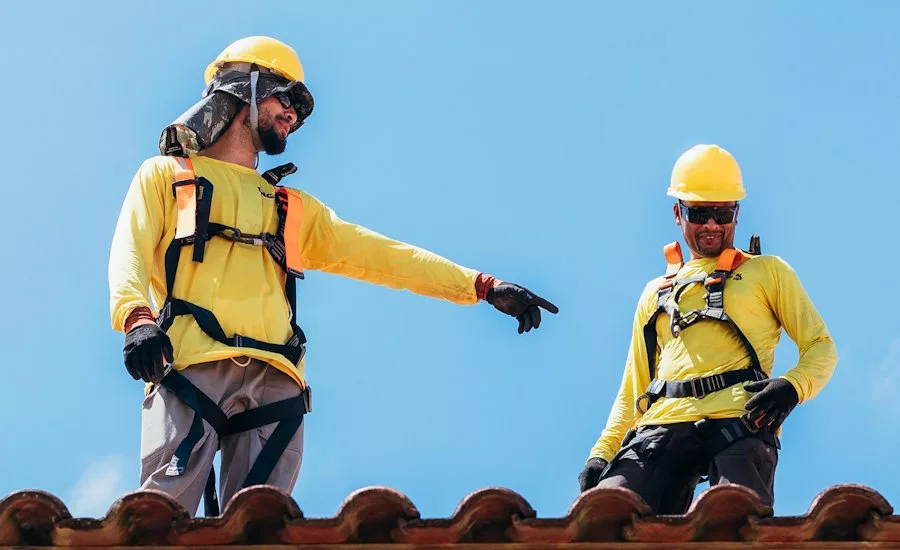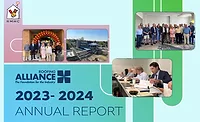IRE 2025
Texas A&M Earns Roofing Alliance Student Competition Crown at IRE 2025
11th annual Construction Management Student Competition draws big crowd despite unseasonably cold weather

The team from Texas A&M University took home first place during this year’s Construction Management Student Competition, sponsored by the Roofing Alliance. Texas A&M received $5,000 in scholarship money from the L.B. Conway scholarship fund.
— Image courtesy of the NRCA
One of the less heralded but most dynamic facets of IRE is its collaboration with the Roofing Alliance, which executes the annual Construction Management Student Competition, celebrated its 11th year during the show in San Antonio.
For the uninitiated, the Student Competition that helps promote careers in roofing management by inviting colleges nationwide to field teams that submit proposals for installing a commercial roof system on a selected project.
This year, nearly one dozen schools participated in the first round, in which teams submitted an extensive bidding package that addressed the various facets involved in installation, from safety to timeline, budget, and material used.
After all vying bids have been received, participating Roofing Alliance members whittle the submissions down to those making the cut, typically between five and six schools. Those chosen to move forward are invited to attend the show and present their bids during an oral presentation on Day Two of the event.
Many of the schools are perennial participants. For 2025, five of the six have been perennial participants, including Auburn University, Bradley University, California Polytechnic State University, Clemson University, Texas A&M University and University of North Florida; the team from UNF was the lone newcomer.
For the first time in two years, the selected competition project was a reroof: The Embassy Suites by Hilton San Antonio Airport Hotel.
The teams were tasked with putting together a proposal that included an overall project estimate, project management plan, safety plan, scheduling framework, and quality control matrix. Teams were paired with industry mentors who made themselves available for guidance.
A whimsical element of the competition is that each team presents as if it were a real contracting firm, offering mock bona fides that, they hoped, would lend an air of authenticity to their presentations. A few teams leaned hard into that component; more on that shortly.
About the Project

The Embassy Suites by Hilton San Antonio Airport Hotel features approximately 2,600 square feet of glass that require replacing but also serve as a crucial light source for the numerous plants that depend on natural light, which posed a challenge for the students.
An Embassy Suites hotel has a unique design feature consistent across all facilities nationwide: a large portion of the hotel’s roof system comprises glass skylights. That element adds complexity that requires unique accommodation, as the students would learn during oral presentations.
The scenario: The hotel is seeking a qualified roofing contractor to submit proposals for the roof and skylight replacement, which will be executed while the hotel remains open for operation. The safety of staff and guests is a paramount concern.
This year, one of the seven judges was Brad Beldon, CEO of Beldon Roofing Company based in San Antonio. His firm performed the hotel’s actual reroof, lending his questions to the students a degree of specificity atypical from the previous two competitions.
Elements of the job included demolishing and replacing approximately 33,000 square feet of roof and 2,600 square feet of glass. The hotel is adjacent to one of San Antonio International Airport’s three active runways, which requires interfacing with officials from the Federal Aviation Administration.
“That reroof was a monster of a project,” Beldon said ahead of the presentations beginning. “Between the glass, dealing with the FAA and trying to get work done with people staying and working, what was supposed to be a 90-day project wound up taking about 18 months.”
Video: Thinking on Their Feet
The team from Auburn University fielding a question from Brad Beldon, CEO of Beldon Roofing, who was one of the judges during the competition. Beldon's company performed the reroof that students used for the mock project.
Under the Klieg Lights
Each team was allotted 15 minutes to present its bids, including using slides to present its budgets, staging plans, materials used and other relevant information. Following each presentation, the judges had 10 minutes to pepper students with questions.
First up was Bradley University, located in Peoria, Ill. Each member took on a specific role, presented their portion of the bid, and then girded for questions by the judges.
Beldon: “What is your plan to ensure the safety of the guests and employees as you demo the roof and replace the glass skylights?”
Bradley U.: “We plan to have netting draped across the ceiling to ensure no debris would fall onto the atrium.”
Beldon: “The hotel owner recently spent thousands of dollars installing vegetation, including trees and plants. How will you ensure those plants get an adequate amount of sunlight so they won’t die?”
Bradley U.: Crickets.
In years past, teams had an opportunity to walk the project ahead of presentations. This year appeared to be an anomaly since the question took about a minute or two to register on the students — and its potential consequences. Finally, the team’s leader noted the netting was translucent and should allow sufficient light to filter through.
Clemson University went through their presentation in the following act, and team captain, Alyssa Owens, introduced themselves from Legacy Roofing. She then offered a backstory on the company’s name based on how her grandfather had always wanted to be a roofer but tragically died in an accident before realizing his dream; the company was named in his honor.
Another noteworthy takeaway from Clemson’s pitch was how Legacy Roofing would ensure the safety of the guests from any debris that could fall from the ceiling: “We plan on installing a temporary acoustic tile roof to prevent any falling material and mitigate the noise.”
What about those thousands of dollars in plants?
Following their pitch, this reporter asked about Legacy’s backstory. Owens, with a sly smirk rising, asked if she sounded convincing. “I made the whole thing up,” she laughed, proud of her acting chops.
In the end, each team gave similar versions of their bids, their approaches to safety, materials and executions varying to degrees of the other, but each team held its own and went through thorough explanations on how they would protect life and limb and get the job done. The consistent timeline hovered around 90 days and budgets ranged from $1.4 million to $2.5 million. One team even went with a cost-plus approach.
No doubt, Beldon was likely chuckling at the timeline.
The Winners
For two-and-a-half hours, six teams of college students stood in front of industry pros, gave their all and whether they would place in the top three or not, each was unarguably a winner. Yet, in the end, not everyone goes home with a trophy.
This year’s winners, in ascending order, were: third place went to Clemson University, which brought back a $1,000 scholarship award for the school; second place was awarded to Auburn University (see video), which brought $2,500 in scholarship money home to Alabama; and first place was taken by Texas A&M University, which nabbed $5,000 in scholarship awards for College Station, Texas.
Individual awards for presentation were given to University of North Florida’s Cheyenne Campbell and Arjun Varadhan of Auburn, runner-up and winner, respectively. Campbell received a $200 gift card and Varadhan pocketed $300.
Looking for a reprint of this article?
From high-res PDFs to custom plaques, order your copy today!







